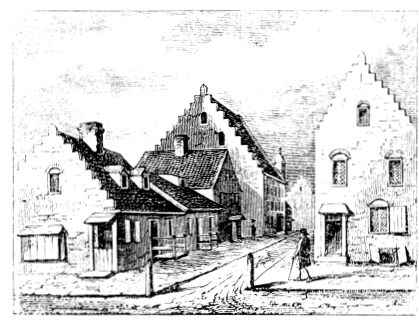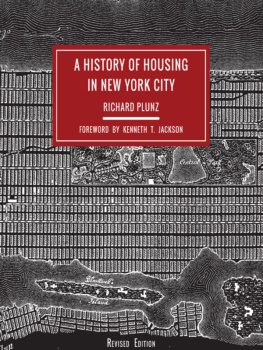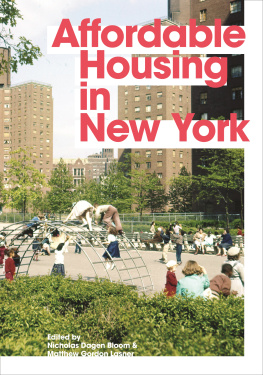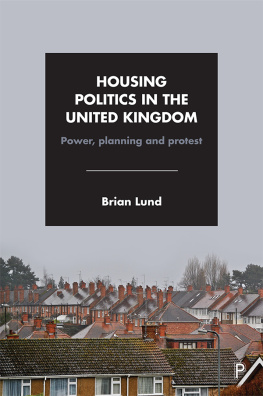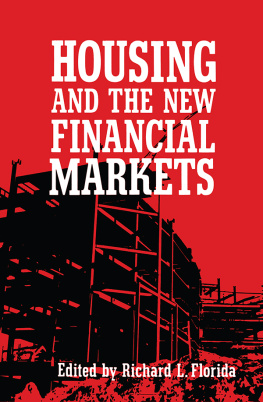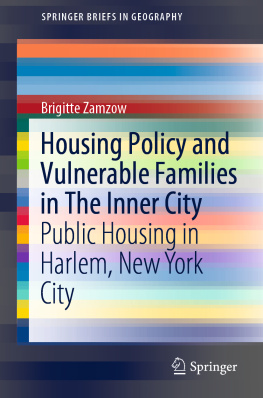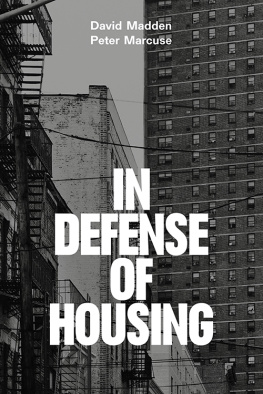Table of Contents
A History of Housing in New York City
Columbia History of Urban Life
The Columbia History of Urban Life Kenneth T. Jackson, General Editor
Deborah Dash Moore,
At Home in America: Second Generation New York Jews 1981
Edward K. Spann,
The New Metropolis: New York City,
1840-1857 1981
Matthew Edel, Elliott D. Sclar, and Daniel Luria,
Shaky Palaces: Homeownership and Social Mobility in Bostons Suburbanization 1984
Steven J. Ross,
Workers on the Edge: Work, Leisure, and Politics in Industrializing Cincinnati, 1788-1890 1985
Andrew Lees,
Cities Perceived: Urban Society in European and American Thought, 1820-1940 1985
R. J. R. Kirkby,
Urbanization in China: Town and Country in a Developing Economy, 1949-2000 A.D. 1985
Judith Ann Trolander,
Professionalism and Social Change: From the Settlement House Movement to Neighborhood Centers, 1886 to the Present 1987
Marc A. Weiss,
The Rise of the Community Builders: The American Real Estate Industry and Urban Land Planning 1987
Jacqueline Leavitt and Susan Saegert,
From Abandonment to Hope: Community-Households in Harlem 1990
Richard Plunz,
A History of Housing in New York City: Dwelling Type and Social Change in the American Metropolis,
First Edition 1990
David Hamer,
New Towns in the New World: Images and Perceptions of the Nineteenth-Century Urban Frontier 1990
Andrew Heinze,
Adapting to Abundance: Jewish Immigrants, Mass Consumption, and the Search for American Identity 1990
Chris McNickle,
To Be Mayor of New York: Ethnic Politics in the City 1993
Clay McShane,
Down the Asphalt Path: The Automobile and the American City 1994
Clarence Taylor,
The Black Churches of Brooklyn 1994
Frederick Binder and David Reimers,
All the Nations Under Heaven: A Racial and Ethnic History of New York City 1995
Clarence Taylor,
Knocking at Our Own Door: Milton A. Galamison and the Struggle to Integrate New York City Schools 1997
Andrew S. Dolkart,
Morningside Heights: A History of Its Architecture and Development 1998
Jared N. Day,
Urban Castles: Tenement Housing and Landlord Activism in New York City, 1890-1943 1999
Craig Steven Wilder,
A Covenant with Color: Race and Social Power in Brooklyn 2000
A. Scott Henderson,
Housing and the Democratic Ideal 2000
Howard B. Rock and Deborah Dash Moore,
Cityscapes: A History of New York in Images 2001
Jameson W. Doig,
Empire on the Hudson: Entrepreneurial Vision and Political Power at the Port of New York Authority 2001
Lawrence Kaplan and Carol P. Kaplan,
Between Ocean and City: The Transformation of Rockaway, New York 2003
Franois Weil,
A History of New York 2004
Evelyn Gonzalez,
The Bronx 2004
Jon C. Teaford,
The Metropolitan Revolution: The Rise of Post-Urban America 2006
Lisa Keller,
Triumph of Order: Democracy and Public Space in New York and London 2008
Jonathan Soffer,
Ed Koch and the Rebuilding of New York City 2010
Frederick Douglass Opie,
Upsetting the Apple Cart: Black-Latino Coalitions in New York City from Protest to Public Office 2014
Edward T. ODonnell,
Henry George and the Crisis of Inequality 2015
A History of Housing in New York City
Richard Plunz
Foreword by Kenneth T. Jackson
Revised Edition
Columbia University Press
New York
Columbia University Press
Publishers Since 1893
New York Chichester, West Sussex
cup.columbia.edu
Copyright 2016 Columbia University Press
All rights reserved
E-ISBN 978-0-231-54310-1
ISBN 978-0-231-17834-1 (cloth : alk. paper)ISBN 978-0-231-17835-8 (pbk. : alk. paper)ISBN 978-0-231-54310-1 (e-book)
Library of Congress Control Number: 2016935679
A Columbia University Press E-book.
CUP would be pleased to hear about your reading experience with this e-book at .
Cover design by Nans Voron
Cover image: The southern half of Manhattan. Reprinted from J. Stbben, Der Stdtebau, of Handbuch der Architektur, part IV, vol. 9, fig. 574.
For MPS and SMSP
Poetry still falls from the skies
into our streets still open.
They havent put up the barricades, yet,
the streets still alive with faces
lovely men & women still walking there,
still lovely creatures everywhere,
in the eyes of all the secret of all
still buried there,
Whitmans wild children still sleeping there,
Awake and walk in the open air.
Lawrence Ferlinghetti,
Populist Manifesto
Contents
Kenneth T. Jackson
W HEN A History of Housing in New York City first appeared a bit more than a quarter century ago, New York was quite different from the metropolis one sees in 2016. The citys skyline, demographics, economy, and very profile have been transformed as its businesses have boomed and its appeal has broadened, keeping New York a major world city.
In 1990, there were no luxury towers along the Manhattan and Brooklyn waterfronts, and the West Side rail yards were not yet lined with apartment buildings emblazoned with the name Trump. No one imagined that billionaire investors from around the globe would spend upwards of $50 million for apartments that they might not even live in. In the Meatpacking District, there was nothing like the Highline or Chelsea Market, and Washington Street was a hangout for prostitutes and drug dealers. The citys crime rate was still rising toward its all-time high in 1992. Women avoided wearing jewelry on the subways, and muggings were as plentiful as flowers in Central Park. New York, many said, was in a downward spiral.
In 1990, New York elected its first African American mayor, David Dinkins; he started a campaign to revitalize the city and lower its crime rate. He was followed in 1994 by Rudy Giuliani, a former federal prosecutor with political ambitions and a tough stance on law and order. In 2002 Michael Bloomberg, a billionaire businessman, helped move the city toward recovery. Bloomberg, who the pundits had said could not win office, did just that on the heels of New Yorks worst tragedy, the destruction of the World Trade Towers on September 11, 2001, when close to 2,800 people died. New Yorks resiliency was highlighted during that tragedy: many said the city would never recover, but it did, and with a vengeance.
In 1990, the city had no Silicon Alley, no Google, no DUMBO, no Wi-Fi. The Yankees and Mets played in historic but antiquated facilities. There was no Barclays Center for sports events and concerts, and Brooklyn remained Manhattans unattractive backwater. The Lower East Side, Bush-wick, and Williamsburg were places to move away from, not to. New Yorks docks were crumbling: there was no Chelsea Piers for recreation, no giant cruise liners tying up along the west side, and no

